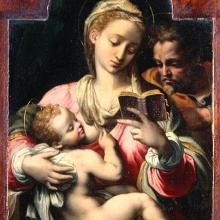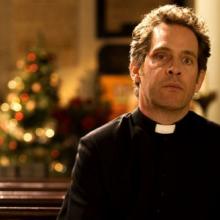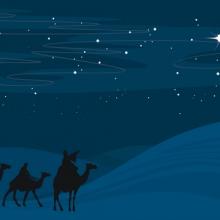Christmas
For a child has been born for us,
a son given to us;
authority rests upon his shoulders;
and he is named
Wonderful Counsellor, Mighty God,
Everlasting Father, Prince of Peace.
~ Isaiah 9:6
On the flight home from Connecticut, where we’d buried my beloved father a few days before Thanksgiving, I watched the film Seeking a Friend for the End of the World and dissolved into a wailing heap of tears and snot.
The premise of the uneven dramedy starring Steve Carell and Keira Knightley is this: An massive asteroid named Matlilda is on a collision course with planet Earth and in three weeks’ time, the world will come to an end. The main characters and others decide how – and with whom – they want to spend the last days of their lives.
Given recent events, this led to some soul searching on my part. If I had three weeks to live, what would I do? Where would I go? Who would I want to make sure I saw? With whom would I want to share my last breaths?
For most of my life the answer has been the same: I’d want to be with my family and, in particular, with my father.
Which is why I ended up bawling my eyes out for the last 90 minutes of the flight home to Los Angeles, much to the dismay of the fellow in the middle seat next to me.
If I had three weeks to live today, I wouldn’t be able to spend any of those moments with Daddy.
He’s in the More, now. On the other side of the veil. In Heaven. Resting in peace. With Jesus.
And I will have to wait until my earthly life ends to see him again face-to-face.
One carol I’ve been humming this Advent is “I Saw Three Ships Come Sailing In.” It’s not one I grew up singing, but I love it. The most popular contemporary lyrics talk about “three ships come sailing in” to Bethlehem on Christmas morning. Bruce Cockburn says the weird lyrics are the result of English folk in the 18th century hallucinating from eating too much ergot in their moldy English bread. Certainly there were no ships sailing into landlocked Bethlehem.
“What Child is This,” written by William C. Dix in 1865 is one of the few Christmas carols I know of that does not have its own musical arrangement. It uses the tune, “Greensleeves” (a traditional English folk song, thought to have been written in the late 16th or early 17th century), which when paired with Dix’s lyrics creates a haunting and beautiful image of the birth of our Lord.
There’s another song that’s less well-known titled “Child of the Poor,” written by Scott Soper (published in 1994). The counter melody blends stunningly with the melody of “What Child is This.” Reading the lyrics, side by side, gives me chills. In part, because it reminds me that hope is found in low places — God could’ve chosen to be raised in comfort (as Moses was). The cross was only the finale of Jesus’ discomfort. “Child of the Poor” honors the death and discomfort we often don’t want to think about while we’re sitting around the fire drinking cocoa.
Whoops. I was joking with a co-worker today about writing a subversive post about how the song “Do You Hear What I Hear” is an extended metaphor for the Roman Empire’s takeover of Christianity, contorting Jesus’ message for its own ends. “Listen to what I say,” orders the unnamed king, as he urges adoration of Jesus and calls for peace — Pax Romana.
I did a quick Wikipedia search, and learned exactly how wrong I was. Rather than a subversive message about the twisting of the Gospel, “Do You Hear What I Hear” was actually a call for peace during the turbulence of the 1960s.
I mean, think about it: the song talks about the humbleness of the announcement of Jesus’ birth – only the night wind and the little lamb have heard about it. This whisper gets passed up to ever-increasing degrees of authority (a grassroots movement if we’ve ever seen one), until the king himself is calling for peace.
I don’t know about you, but I’m pretty sure I have sung “O Little Town of Bethlehem” every year on Christmas Eve for my entire life. But I believe this carol’s lyrics, specifically the words of the first verse, invite a little more thought than we normally give them.
O little town of Bethlehem
How still we see thee lie
Above thy deep and dreamless sleep
The silent stars go by
Yet in thy dark streets shineth
The everlasting light
The hopes and fears of all the years
Are met in Thee tonight
For now let’s ignore the historical inaccuracies of the song, and focus on what the words mean, especially the last four lines. How beautiful is it that through the dark world a light came to bind together the hopes and fears of all the years (I choose to see it as past and future) in Jesus?
When I go home for Christmas, I always end up pulling out the old Christmas songbook from inside the piano bench and working my way through while my mom cooks dinner. I don’t really read the music as much as I read the chords and play by ear. Good King Wenceslas is a beautiful song musically, but is one of the most fun songs to play because of the never-ending chord changes.
I never really considered what the song was about, being raised in a school system that taught of the tyranny of monarchies and the Revolutionary War. Medieval leaders ruled in an age of knights, castles, and oppressed peasants. But then there was Wenceslas (who I now know was the Duke of Bohemia).
Advent candles lit round the world declare our longing for the coming of Christ. We wait. And, in our waiting we hope, we pray, we yearn. Advent is a season where our energies and passions for all things to be made right are kindled. Christ, the precious Baby in the manger, is coming for us all to celebrate. Consider Him.
Despite the hunger, the fatherless, the ailing. Despite the wars and senseless violence. Despite all of the reasons to say there is no redeemer.
We wait for the Christ child.
Our faith is rooted in such anticipation. Mockers have innumerable examples to declare the reasons why God is dead. Centuries of proof. Holocausts, molestation, shame. The Church waits despite its own pollution and contribution to the lack of justice.
Yet these things merely point to the coming of the Child. If the world were made right by our collective longings for occupation, for the 99 percent, for cosmic good, we’d see equitable dispersion of wealth, of food, of housing. We’d live the Marxist dream of community. We would all be haves.
Have you burned out on fiscal cliff debate yet? Depressed that our Congress has still failed to renew the incredibly noncontroversial Violence Against Women Act? Well, while Sojourners cares deeply about both of the issues, we’re also very ready to celebrate this season of Advent, our Savior’s birth, and all of the family time and Christmas cookies that come with it.
So here it is: The Top 5 Ways to Get Into the Christmas Spirit.
This Christmas, for the spirituality-and-pop-culture enthusiasts on your gifting list, consider the following: Be kind and rewind.
Give them the gift that keeps on giving ... long after the series has been cancelled.
Rev. The Vicar of Dibley. Saving Grace. Davey and Goliath. Pushing Daisies. Six Feet Under. The Book of Daniel. Lie to me. Lost. And Northern Exposure.
I sat behind a couple of folks on a plane to Seattle this morning who were discussing their distress about a so-called war on Christmas.
“Memorial Day is a holiday,” said the man in a santa hat with disgust. “July 4th and Thanksgiving are holidays. Christmas is, well, Christmas!”
“Absolutely,” nodded the woman next to him. “It’s just more evidence of this war against Christmas.”
On the way off the plane, a flight attendant made the grave mistake of wishing the man happy holidays. He stopped the line of outgoing traffic behind him (including me) to correct her. She demurred, looked toward her feet and smiled sheepishly.
We Christians have a long and storied history of playing the martyr, whether there’s actually anyone persecuting us or not.

Sagrada Familia by Pompeo Cesura. RNS photo courtesy www.cattoliciromani.com, via Wikimedia Commons
At its heartwarming core, Christmas is the story of a birth: the tender relationship between a new mother and her newborn child.
Indeed, that maternal bond between the Virgin Mary and the baby Jesus has resonated so deeply across the centuries that depicting the blessed intimacy of the first Noel has become an integral part of the Christmas industry.
Yet all the familiar scenes associated with the holy family today — creches and church pageants, postage stamps, and holiday cards — are also missing an obvious element of the mother-child connection that modern Christians are apparently happy to do without: a breast-feeding infant.
Jesus certainly wasn’t a bottle baby. So what happened to Mary’s breasts? It’s a centuries-old story, but one that has a relatively brief answer: namely, the rise of the printing press in 15th-century Europe.
With the advent of movable type, historians say, came the ability to mass-market pornography, which promoted the sexualization of women’s bodies in the popular imagination. What's more, the printing press enabled the wider circulation of anatomical drawings for medical purposes, which in turn contributed to the demystification of the body. Both undermined traditional views of the body as a reflection of the divine.
I asked a small group of second-graders what they would like to find inside their mailboxes. That was after we read a story about a goose who opened her mailbox and found a kite. I expected to hear answers of things: video games, toys or basketballs. But the first student who raised her hand looked at me with sincere, big brown eyes and said, "I'd like to find a letter from my dad."
In my classroom, my kids say the profoundest things.
As we entered the holiday season, I thought about the answer that student gave me. I thought about what other of my 7-, 8- and 9-year-olds were saying about the holiday season.
For three years, I lived and worked in a large housing project in Louisville, Ky. I was a middle-class, white graduate student, and my background clouded how I saw the people around me. But I finally began to see clearly.
In the church where I grew up, the first Sunday in Advent was dubbed the “hanging of the greens.” On that special Sunday, we sang carols in the decorated sanctuary, all culminating in the children’s live nativity scene. The service never changed from year to year. The only variables were how many kids needed roles and which young child would get stage fright, thus leaving part of the the story without visual representation.
It always seemed like the doves were cursed. The doves rarely remained on stage for the entire performance. Over the years, I was a variety of animals — a wise man, a shepherd, and finally Joseph. I never got stage fright. I was never a dove. I can only imagine what my mother would’ve done if I had been that kid.
It took me years to realize that there was a character missing from my congregation’s telling of the story. We always left out King Herod.
This was a huge oversight, because Herod plays a major role in Matthew’s account of Jesus’ birth.
I’ve been really lucky this month to hear some of my co-workers’ reflections on the social justice implications of their favorite Christmas carols. It’s been a great opportunity to reflect back on what it is we sing and celebrate each year, the truths we profess without even knowing it.
Naturally, I wanted to get involved, as well. As I was running through the songs I love, "Joy to the World" suddenly popped up in a new light:
Joy to the World, the Lord is come!
Let Earth receive her King;
Let every heart prepare Him room,
And Heaven and nature sing,
And Heaven and nature sing,
And Heaven, and Heaven, and nature sing.
This Advent, as we wait for the true light who is coming into the world (John 1:9) we pause and reflect on our Christmas hope. As a friend said last night, we do not linger forever in uncertainty but as an expectant mother who labors in anticipation of the joy her child will surely bring.
Our assurance of salvation — past, present, and future — depends on the unique person of Jesus Christ and our relationship to him, and there's perhaps nothing more central to Jesus and our relationship with him than that he became flesh, was made like us in every respect (Heb. 2:17), so that by grace we might become partakers of his divine nature (2 Peter 1:4).
This isn't something the church merely teaches but an event of history, revealed for all men and women in the one-of-a-kind person Jesus is, the human and divine Son of God. From the moment of Christ's conception, eternity himself inhabits time so that events of his life on earth long since past are forever present to us in Jesus. This is one reason our joy at Christmas is so palpable and real ... when we worship Jesus at Christmas, we are once again with Mary and Joseph on that cold, dark night as they swaddle “he who made the starry skies” and lay him in a manger.
“Faith is recognizing that if at Christmas Jesus became like us, it was so we might become more like him,” wrote the well-known preacher and activist William Sloan Coffin. He goes on to add, “We know what this means; watching Jesus heal the sick, empower the poor, and scorn the powerful, we see transparently the power of God at work.”*
Christmas really is about seeing the power of God at work, but far too often pastors and churches fail to tell this story. Oh sure, we preach about Mary and Joseph, Jesus being born in a Bethlehem manger, and the Magi following a star to find him and offer gold, frankincense, and myrrh. My fear is that the story has grown familiar and routine. We have forgotten its power and no longer see its challenge.
In Matthew’s Gospel, the Magi seek out Jesus after hearing of his birth. In order to find him they ask King Herod where they can find the new king. This, of course, is news to Herod who is surprised to learn that his title has been claimed by a baby. Herod consults his advisors and then reacts with the expected calmness of a leader anticipating a conflict, which is to say his response is not calm at all.
This story is an announcement that Jesus has arrived to challenge the powerful. The Messiah was not born meek and mild.
There are many ways to celebrate the coming of the light in this dark season of the year, including the Winter Solstice, Hanukah, Kwanza, and Christmas. Christmas is supposedly a Christian holiday, but the orgy of consumption that accompanies this holiday in the United States makes that questionable. How ironic it is that people celebrate the birth of a poor baby born in a stable (as the story goes) by spending billions on "stuff" that will ultimately end up in overflowing landfills. However, Christian or not, many are swept along by the dominant media message: "Buy gifts for your loved ones to show them how much they are loved and how precious they are."
The pressure can be hard to resist.
This may not present a problem for those who practice a Christianity that is conformed to consumer culture, but for those who seek to follow Jesus it challenges us with one of his core teachings: "You cannot serve both God and mammon." Mammon: wealth, riches, money, stuff.
One of the most fresh and challenging interpretations surrounding the Christmas narrative was produced by South Africa’s renowned theologian, the late Steve de Gruchy. In regards to the Magi and their visit with Joseph, Mary, and the newly born Jesus in Matthew 2: 1-12, de Gruchy offers a striking proposal surrounding the biblical text and its direct relationship with cooperative efforts between those in the so-called global north and south.
...
Among other things, a key insight into this portion of the Christmas narrative is that God is revealed through the vulnerability of poverty and marginalization. The main characters of the Christmas plot are not wealthy and prosperous high-rollers, but the downtrodden and vulnerable poor who stand as deliberate reminders of how God is in solidarity with those who are too often forgotten and oppressed. If Mary and Joseph were people of wealth and privilege, they surely would have received room at the inn, yet God shows an alternative to the common hierarchies of status in our world, and such pushed-aside people are given highest priority as the bearers of Christ.
There is a line from a Gerard Manley Hopkins poem about the Virgin Mary that describes the baby Jesus as “God’s infinity, dwindled to infancy.” The line captures perfectly the beautiful but also shocking idea, central to Christianity, that the infinite God who created the universe also chose to descend, dwindle, become small, become helpless, become dependent on human beings.
Hopkins is right: the baby Jesus is not merely a sentimental or cute idea but is potentially radical, transformative, and controversial.
I can remember hearing several times as a middle and high schooler that Christians lie the most when they sing. These claims generally came from the mouths of college-aged worship leaders during emotional praise segments at mission camps and conferences. They were usually followed up with a heartfelt plea to raise honest words and promises to God during the next song. (And if we really meant it, we would ignore the burning stares of our judgmental, worldly peers and come down front for our seventh altar call.)
Though I generally don’t remember these scenes and indictments fondly, I have recently been contemplating the idea of honest worship, especially in relation to the Christmas season. I mean, how often do we memorize a whole song and sing along to it regularly without really stopping to contemplate the lyrics? And even when we do realize what we’re singing, how often do we actually let those words transform our hearts or actions or perspectives?
All of these thoughts started stewing in my mind during my Thanksgiving vacation two weeks ago. Per usual, I started playing Christmas music the day after Thanksgiving (and by the day after I mean a few days before). As I was washing dishes, belting out my favorite version of “O! Holy Night,” I was suddenly struck with the thought What am I singing? Read the lyrics below to see if you get what I mean. (Hint: my moment happened somewhere around the second verse.)


















